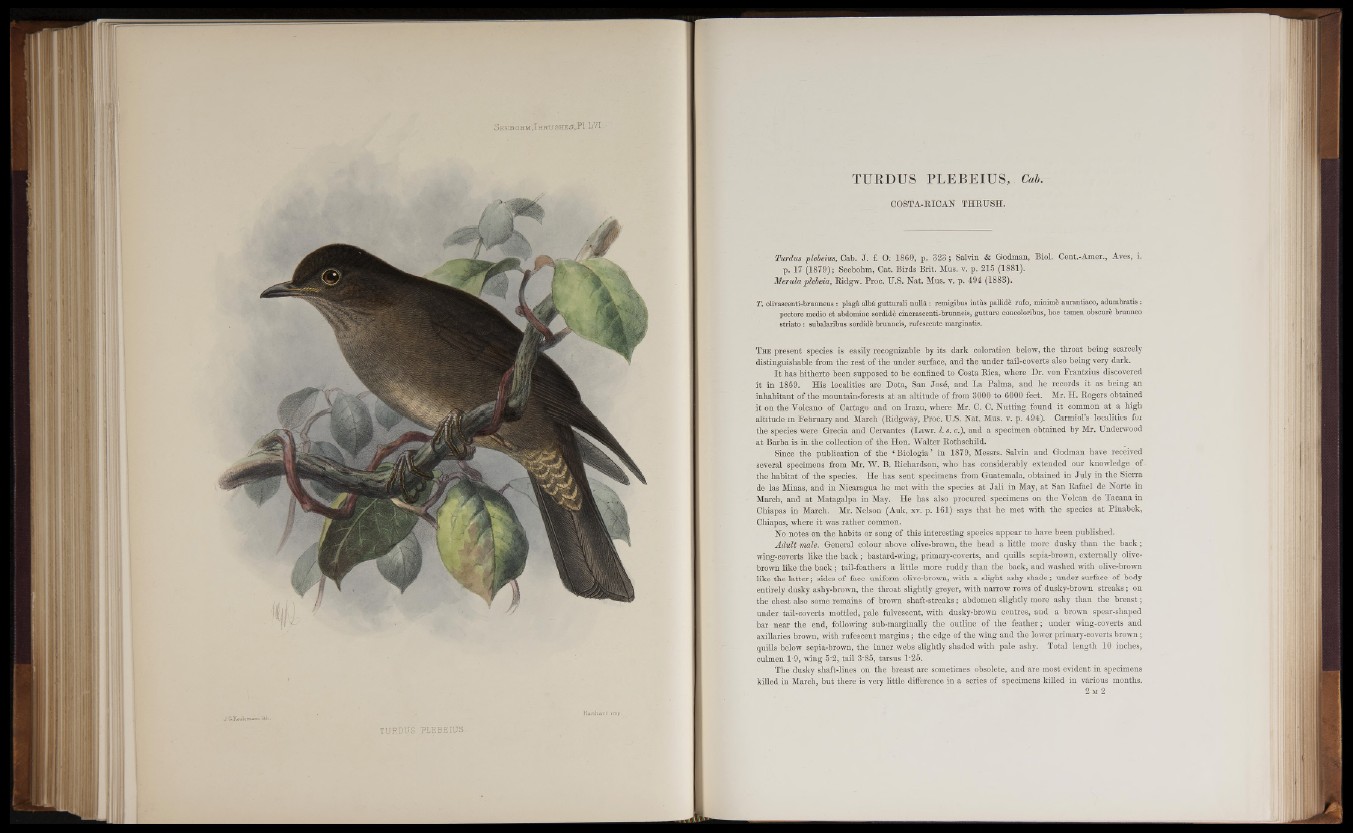
f URDUS P L E B E I U S .
TURDUS PLEBEIUS, Cab.
OOSTA-BICAN THEUSH.
Turdus plebeius, Cab. J. f. O; 1860, p. 323 ; Salvin & Godman, Biol. Cent.-Amer., Aves, i.
p. 17 (1879); Seebohm, Cat. Birds Brit. Mus. v. p. 215 (1881).
Merula plebeia, Ridgw. Proc. U.S. Nat. Mus. v. p. 494 (1883).
T. olivascenti-brunneus : plagâ albâ gutturali nullâ : remigibus intùs pallidè rufo, minimè aurantiaco, adumbratis :
pectore medio et abdomine sordidè cinerascenti-brunneis, gutture concoloribus, hoc tamen obscure brunneo
striato : subalaribus sordidè brunneis, rufescente marginatis.
The present species is easily recognizable by its dark coloration below, tbe throat being scarcely
distinguishable from the rest of the under surface, and the under tail-coverts also being very dark.
It has hitherto been supposed to be confined to Costa Rica, where Dr. von Frantzius discovered
it in 1859. His localities are Dota, San José, and La Palma, and he records it as being an
inhabitant of the mountain-forests at an altitude of from 3000 to 6000 feet. Mr. H. Rogers obtained
it on the Volcano of Cartago and on Irazu, where Mr. C. C. Nutting found it common at a high
altitude in February and March (Ridgway, Proc. U.S. Nat. Mus. v. p. 494). Carmiol’s localities for
the species were Grecia and Cervantes (Lawr. I. s. c.), and a specimen obtained by Mr. Underwood
at Barba is in the collection of the Hon. Walter Rothschild.
Since the publication of the ‘ Biologia ’ in 1879, Messrs. Salvin and Godman have received
several specimens from Mr. W. B. Richardson, who has considerably extended our knowledge of
the habitat of the species. He has sent specimens from Guatemala, obtained in July in the Sierra
de las Minas, and in Nicaragua he met with the species at Jali in May, at San Rafael de Norte in
March, and at Matagalpa in May. He has also procured specimens on the Volcan de Tacana in
Chiapas in March. Mr. Nelson (Auk, xv. p. 161)-says that he met with the species at Pinabek,
Chiapas, where it was rather common.
No notes on the habits or song of this interesting species appear to have been published.
Adult male. General colour above olive-brown, the head a little more dusky than the back ;
wing-coverts like the back ; bastard-wing, primary-coverts, and quills sepia-brown, externally olive-
brown like the back ; tail-feathers a little more ruddy than the back, and washed with olive-brown
like the latter ; sides of face uniform olive-brown, with a slight ashy shade ; under surface of body
entirely dusky ashy-brown, the throat slightly greyer, with narrow rows of dusky-brown streaks ; on
the chest also some remains of brown shaft-streaks ; abdomen slightly more ashy than the breast ;
under tail-coverts mottled, pale fulvescent, with dusky-brown centres, and a brown spear-shaped
bar near the end, following sub-marginally the outline of the feather; under wing-coverts and
axillaries brown, with rufescent margins ; the edge of the wing and the lower primary-coverts brown ;
quills below sepia-brown, the inner, webs slightly shaded with pale ashy. Total length 10 inches,
culmen 1 9 , wing 5*2, tail 3’85, tarsus 1*25.
The dusky shaft-lines on the breast are sometimes obsolete, and are most evident in specimens
killed in March, but there is very little difference in a series of specimens killed in various months.
2 m 2